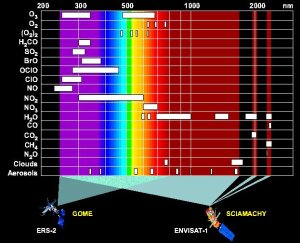 |
 |
|
5. The measurement range of SCIAMACHY includes a wide area of different wavelengths, suitable for the monitoring of diverse chemical compounds. © IUP Bremen
Please click the image for a full view. (60 K)
|
|
 |
What we perceive with our eyes and call light is from the physical point of view electromagnetic radiation. Beginning with violet via blue green yellow orange and red the energy of this radiation decreases. SCIAMACHY also observes the energy rich ultra-violet light (beyond the violet) and the energy poor infrared light (beyond the red).
A lot of molecules take up light in this range of wavelengths (absorption), which therefore does not reach the instrument. From the amount of absorbed light we can work out the concentration of molecules in the air (given below for ozone in trillion (1012) molecules per cm3).
|







